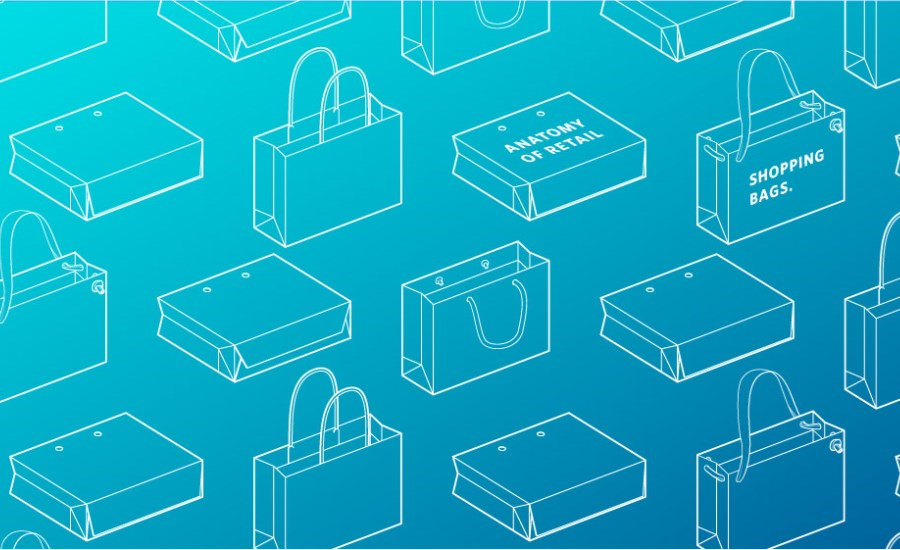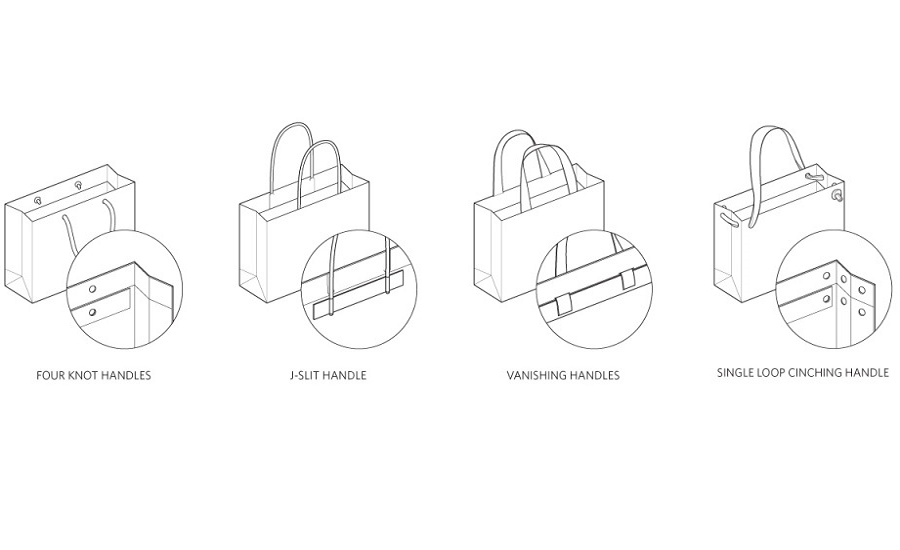We break down the elements of retail shopping bags, because nothing about them is skin deep. Structural packaging design, graphics and printing processes all work in tandem to create the “walking billboard” we’re used to seeing every day. But what are all the parts of a shopping bag? What are their roles and how can we transform a standard paper bag with two handles into a luxurious brand experience? Put your gloves and mask on; the retail packaging experts at Design Packaging are about to show you the anatomy of a retail shopping bag.
TURN TOP: The inner flap of a shopping bag that folds in to create a smooth, finished edge.
Turn tops not only create a smooth, finished edge for retail shopping bags that hides the reinforcement panel, it’s also provide the structural support needed to attach handles. The reinforcement panel is a strip of grey-board hidden inside the turn top, providing structural integrity, weight distribution, and maintaining a crisp wrinkle-free face. Without the reinforcement panel, heavy items in shopping bags would cause the handles to tear through the turn-top, or put too much tension between the handles, creasing the face of the bags.
HANDLE: The physical point of contact consumers have with your brand.
-
Four Knot Handles
: Four Knot handles are standard shopping bag handles in which two loops, whether rope or ribbon, are knotted along the interior of the turn-top through diecut holes on the face of the shopping bag. The name refers to the four knots created by the two handles.
-
J-Slit Handles: J-Slit Handles derive their name from the shape of the diecuts made in the turn-top allowing the handles to be glued into the bag via machine assembly. Handles of this construction are usually made of twisted paper and glued into the turn top of the bag. There are no holes on the outside of the bag where it strings through like its Four Knot counterpart.
-
Vanishing Handles: Probably one of the most sleek and minimal handle variations is the Vanishing Handle. Utilizing a flat faced fabric as the handle substrate, the ends enter through the top edge of the turn top and glues directly to the reinforcement board. There are no holes or knots, and the result is a slender, minimal approach. This can be done with rope, or other handle materials, but the bulkier variations will wrinkle the paper around the handles and turn top.
- Single Loop Cinching Handle: This type of handle uses a long single loop rather than two handles. The handle enters through two diecut holes in the folded gusset of one side, and then loops to the opposite side of bag to loop through the two diecut holes there. The knotted ends are exposed to keep it from slipping out, and also offer a tactile component for added dimension and drama. When the handle is drawn and thrown over your shoulder, it cinches the top closed to create an A-frame bag!
Determining handle spacing is an often asked question, Creative Director Evelio Mattos recommends starting with no more than a 7” span between handle holes on large shopping bags, and no less than 3.5” on small shopping bags. As part of our design process, once we build prototypes, we can make slight adjustments. (See image 2)
DROP: The distance from the top of the bag to the bottom of the resting handle.
When you discuss the distance of the resting handle from the turn top to the bottom of the loop, it’s referred to as the drop. Usually luxury retail shopping bags will have a longer drop while shopping bags for mid-tier brands may have a shorter drop.
FACE : The front panel of the shopping bag that does not contain the crease line.
The Face panel is free from any obstruction compared to the back panel on which the score line is located. Art can be placed without danger of creasing and cracking.
BACK: The rear panel of the shopping bag containing the crease line.
When the shopping bag is folded flat, the crease line on the back allows the bag to collapse. To find the placement of the crease line, measure half the dimension of the bottom gusset. Place the crease line that distance from the bottom of the bag on the back panel. Avoid having critical artwork, such as logos, or hot stamped artwork fall on the crease line to avoid creasing and cracking.
SIDE GUSSETS: Left and right side panels of the retail shopping bag.
The side gussets are just as important as the face and back of the bag and are a great area to add a contrasting color or design. Call to action messages are often printed on these panels as supplemental information since it avoids disrupting the rest of the artwork. Consider the creases on the side gussets when placing artwork; each side gusset has a vertical line running from top to bottom, as well as a triangle at their base.
BOTTOM GUSSET : The bottom panel of the retail shopping bag.
-
Standard Bottom
: The standard bottom gusset is the most common construction in which the bottom gusset folds flat to the back of the bag.
-
Inverted/Japanese Bottom:
Most commonly referred to as the inverted bottom, the gusset does not fold to the back of the bag. Instead, it folds inwardly into the bag itself. This provides a modern, clean look by not utilizing crease lines on either side of the bag.
-
Machine-Made Bottom
: Easily identified by the “envelope” look, this type of gusset is specifically designed to be folded by machine. Flaps are shorter and meet towards the middle. During factory production, the unfolded flaps look like a rectangular tube, which are then folded and glued together automatically. This is a more cost-effective option than the hand-made bottom.
-
Handmade Bottom
: The handmade bottom is easily identifiable by a clean, flat bottom without folds or creases. The construction of the bottom gusset panels are specifically designed to be folded by hand. Flaps are longer than the machine made construction, extending the flaps closer to the edge of the opposite side of the bottom panel. During factory production, the bottom gusset panels are hand-folded and glued, with the final large flap covering the other three, presenting a more seamless, luxurious aesthetic.
- Bottom Board: A separate board panel inserted into the interior bottom gusset for structural support.
The bottom board has a function similar to that of the turn top reinforcement board, except that it’s exposed and not covered. Aside from keeping the bag flat on the bottom, the bottom board distributes internal weight and supports the integrity of the bag to not collapse from the weight of the contents inside. If you know heavier items are going into the shopping bag, choose a heavier stock of board. Because the bottom board is exposed, this area can be used for art and extra messaging revealed as a surprise when contents are removed. (See image 3)












